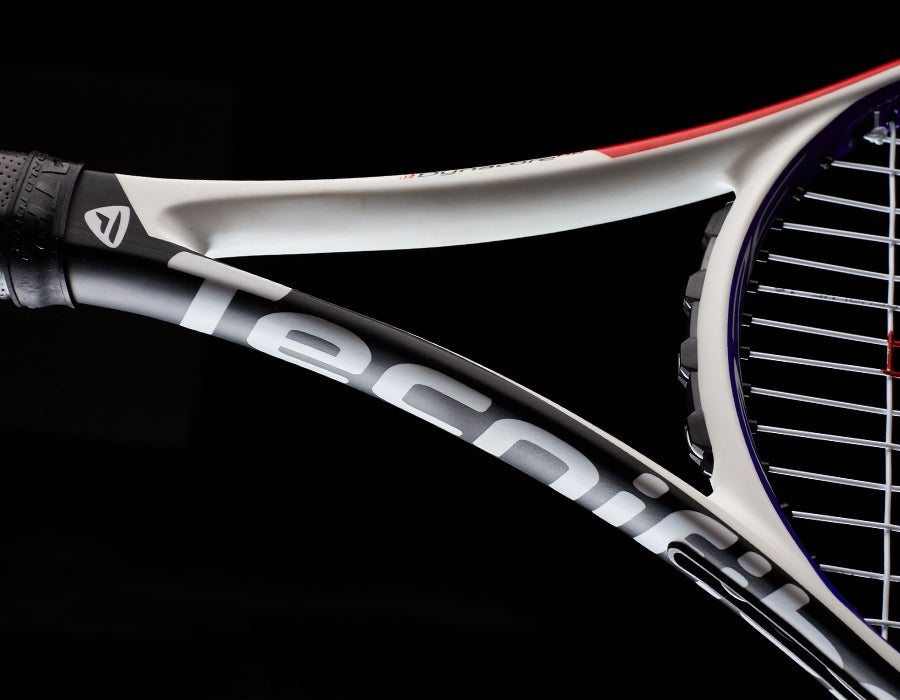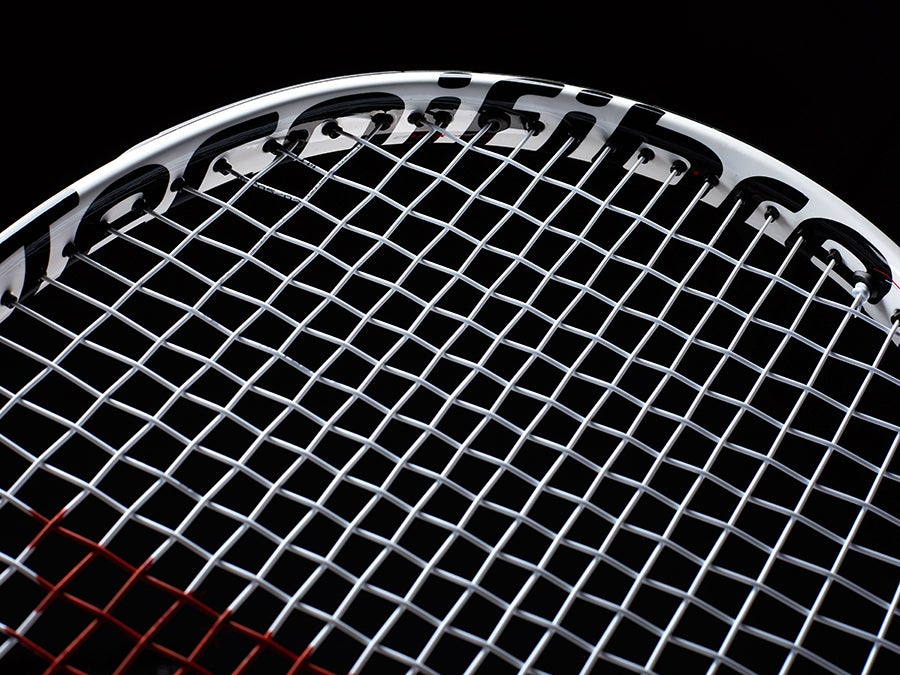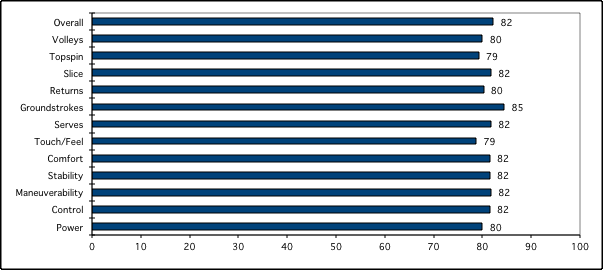Tecnifibre ATP TFight 305 XTC Racquet Review
| Groundstrokes | 85 |
|---|---|
| Volleys | 80 |
| Serves | 82 |
| Returns | 80 |
| Power | 80 |
| Control | 82 |
| Maneuverability | 82 |
| Stability | 82 |
| Comfort | 82 |
| Touch/Feel | 79 |
| Topspin | 79 |
| Slice | 82 |
Superb control, stability and a comfortable feel made the Tecnifibre ATP TFight 305 XTC a massive hit among our playtesters. Tecnifibre has redesigned its TFight racquets with Xtreme Touch Construction, which is designed to improve flexibility, touch and stability. The TFight 305 also features a fairly beefy swingweight of 329, a 65 RA and a more control-oriented 18x19 string pattern. Our playtesters were pleasantly surprised with this racquet's performance, and they discovered that they preferred this 11.4-ounce version over its heavier siblings. Impressive from the baseline, the 305 XTC provided our playtesters with easy access to depth and great control and consistency, which allowed them to swing big and confidently hit their targets. The transition to net was smooth, and the stability and touch were satisfactory for a racquet of this weight. The TFight 305 provided nice pop, decent access to spin and the ability to crank out substantial pace on serves. Overall, this racquet was a clear standout among the TFight series. Intermediate to advanced players who are looking for a stable player's racquet with plenty of plow through and control should not overlook the TFight 305 XTC.
Upsides
- Stability
- Control
- Plow through
Downsides
- Nothing we could agree on
Bottom Line
Big hitters might be surprised by how much stability, control and plow through this "lighter" racquet delivers.
Ability
Intermediate to advanced
Groundstrokes - Score: 85
Our playtesters were thrilled with the playability of the TFight 305 XTC from the baseline. The racquet's relatively light 11.4-ounce strung weight did not equate to a lack of stability. On the contrary, our playtesters found that this racquet actually outperformed its heavier counterparts. Michelle was quick to pick up on which racquet she preferred from her round of Tecnifibre playtesting. She explained, "I playtested both this 305-gram TFight and the 320-gram version side by side, so I will make a lot of comparisons between the two racquets in my comments. The first day I hit with both I was shocked to find myself gravitating toward the lighter TFight 305 XTC. The sweetspot felt large, and this racquet's balance just worked out best for me. I found decent plow through and consistency compared to the TFight 320, which had a smaller sweetspot and some inconsistency. The 18x19 string pattern offered me just the right amount of control off the ground. I could hit out and still gain good depth into the court, and I could hit my spots pretty accurately. The feel was not too brassy or uncomfortable. I could hit hard balls, and I could angle my balls off the court effectively when I wanted to. This became a great way for me to win points against some of my speedier opponents; I felt confident pulling them off the court and then either taking the next shot behind them or to the open court."
Troy also had few complaints from the baseline. He said, "I was surprised to find a high level of stability and plow through from this 305-gram racquet when I was swinging away from the baseline. During hard-hitting rallies this racquet had enough mass in the head to allow me to find easy depth on my groundstrokes. This TFight 305 XTC felt a bit plusher and more comfortable at impact compared to the TFight 320 XTC. The 18x19 string pattern allowed me to feel plenty connected to the ball, and I was able to swing big on my forehands without fear of the ball flying on me. I could also generate plenty of spin to dip the ball cross court or cut the ball with heavy backspin on my slice. I really had very little to complain about on groundstrokes, although I would likely add some weight to the handle to try to reach a balance of 7 to 8 points head light."
The positives continued with Chris, who said, "The TFight 305 XTC had a fantastic blend of maneuverability and stability. The racquet felt light and easy to get around, yet on a full swing it felt more solid than the TFight 320 XTC. The stringbed felt very forgiving, with a large sweetspot and a consistent response. Getting spin was easy; the stringbed did a good job of grabbing the ball, and it wasn't difficult to generate the racquet head speed needed for lots of spin."
Although this racquet felt beefier through the air than he expected, Mark was quick to adjust. He elaborated, "I tested the new TFight 305 XTC along with the 320-gram version, and from the very first swing I felt like the 305 XTC swung heavier than the 320. I quickly adapted to the 305's slightly different feel, and before the end of my initial hitting session I had already developed a preference toward the 305 XTC. A healthy swingweight, an 11.4-ounce static weight and a slightly tip-light balance complemented my groundstroke with quality and consistency."

Volleys - Score: 80
The TFight 305 XTC held its own at net, with enough stability to handle pace. It also packed enough feel to place touch shots effectively. The TFight 305 XTC's specifications catered to Mark's preferences at net. He said, "I liked the TFight 305 XTC's combination of weight and balance at net. Its 11.4-ounce strung weight made it easy for me to get it into position on time, and the 329 swingweight helped make volleys my favorite shot to hit with this racquet. At full stretch or with off-center contact of the ball, the TFight 305 XTC never quivered in my hand."
Chris found it easy to transition to the net. He said, "I continued to enjoy this racquet when attacking the net. Again, it felt easy to maneuver, yet it was still solid enough to get the job done. I liked the touch I found on drop volleys. The TFight 305 XTC felt a little crisper than the TFight 320 XTC, and it was close to my Tecnifibre TFlash 300 PS in its response. Despite being a bit firmer, I thought the racquet still offered a nice and comfortable feel."
Troy was satisfied with his play at net and enjoyed the TFight 305 XTC's comfortable response. He noted, "The TFight 305 provided a decent amount of control, and it was pretty easy to maneuver when I went to the net. This racquet allowed me to locate my targets with ease. It wasn't as precise as the Volkl V-Feel 10 (320g), but the command over the ball was good enough for me to feel confident volleying near the lines. Even though this racquet is lighter than my racquet of choice, I found good stability on contact. Against hard hitters, this racquet stood its ground when I played harder hitters, and it allowed me to block my volleys back with easy depth. I was pleased to find that the sweetspot was a bit more spacious than the TFight 320 XTC's sweetspot. This 305-gram version also had more flex in the frame than the 320 version, making it feel a bit plusher on contact."
Michelle didn't have any issues at net, but she wasn't quite blown away either. She said, "The racquet felt fairly stable at the net. I didn't have anything earth shattering happen when volleying. This racquet was fairly seamless to volley with and had point-and-shoot playability. I didn't experience any severe flopping or twisting in hand."

Serves - Score: 82
The whole playtest team agreed that the ATP TFight 305 XTC was a joy to serve with. Troy relished the control, maneuverability and pop that this racquet added to his serve. He said, "The lighter weight of this racquet, compared to my racquet of choice, allowed me to generate easy head speed. The 18x19 string pattern had me dialed in when I was searching for my targets, and I also found ample spin potential for my spin serves. This racquet was a bit lower powered on my serves than the Head Graphene 360 Speed Pro, but I still felt like I could generate easy power on my flat first serves. Kick serves were coming off this racquet with plenty of pace and spin. I felt confident attacking my second serves with a lot of racquet head speed, which resulted in the ball jumping off the court with a lot of action."
While it didn't have the sheer serving power that Michelle tends to gravitate toward, the TFight 305 still helped her start points with an edge. She said, "I found a nice blend of power and precision when serving with this racquet. It didn't have the same heft as, say, a Wilson Pro Staff RF97 Autograph, but it still helped provide nice pop, and I could target my spots fairly easily. Despite the tighter string pattern, I also got decent spin; specifically, I found I could cut my slice serves effectively and go straight into the body to handcuff my opponent or pull them off the court to their right."
Chris also found success serving with the TFight 305 XTC. He described, "I served well with this racquet. It felt easy to generate racquet head speed, which opened up solid doses of pace and spin. While the beam of the racquet didn't feel as responsive as my regular racquet, the added swingweight more than made up for it in the power department. Compared to the 320-gram version, the stringbed was more forgiving and allowed me to take more risks with my targeting."
Mark loved the feel of the TFight 305 XTC on serves. He noted, "Although PlaySight indicated that not much about my serve changed MPH-wise, I felt like my serve was bigger and more effective when playing with the TFight 305 XTC."

Returns - Score: 80
Thanks to the substantial swingweight of the TFight 305 XTC, our playtesters were able to step up and return serve with confidence. Troy said, "I found that I could block serves back deep in the court whenever I stretched out for a return, and this racquet really packed a punch when I had time to take a big swing at my return. The 18x19 string pattern allowed me to be aggressive and flatten out my returns without fear of overhitting. There was plenty of control for me to pick my targets while returning during doubles play. My slice backhand returns were penetrating the court with a lot of pace, and I could easily push the server back with depth. The stability that this racquet provided helped me keep a compact swing on my backhand returns and still make effective shots."
Chris felt that this racquet's speed and maneuverability gave him a lot of options on his returns. He said, "The TFight 305 XTC was a fun racquet to return with. I liked how fast it felt. It was easy to accelerate when I was being aggressive and easy to get into position when I was rushed. Access to spin was impressive. I had a lot of success moving in, taking the return early and driving my backhand slice return. I found enough stability from the TFight 305 XTC to drive through my slice backhand and take the offensive at the start of the point."
The TFight 305 XTC helped Mark optimize his return motion. He said, "Typically my return of serve is a neutral shot, and I have never been the player to hit the return of serve on the rise. However, I am always looking for the chance to at least swing over the top of the ball rather than rely on my chip style of returning serve, and with the TFight 305 XTC I was able to hit through the ball on my return."
Michelle was quick to find her groove on returns, although she would have liked a touch more stability at times. She explained, "I felt pretty dialed in with my returns. I was confident taking big swings off weaker serves, and I knew I could lean on the 18x19 string pattern to help me target and control my shots. When I saw heavier, faster serves coming at me the stability was decent, but I craved just a bit more when I was stabbing at big first serves."
Overall - Score: 82
| Technical Specifications | ||
|---|---|---|
| Length | 27 in | 69 cm |
| Head Size | 98 sq in | 632 sq cm |
| Weight | 11.4 oz | 323 gm |
| Balance Point | 13.18 in 33 cm | 3pts Head Light |
| Construction | 22.5mm/22.5mm/21.5mm | |
| Composition | Dynacore HD/Graphite | |
| String Pattern | 18 Mains / 19 Crosses | |
| Babolat RDC Ratings | ||
|---|---|---|
| Score | Grade | |
| Flex Rating | 65 | Range: 0-100 |
| Swing Weight | 329 | Range: 200-400 |
| Chris' Scores | |||
|---|---|---|---|
| Power | 8.1 | Serves | 8.2 |
| Control | 8.4 | Groundstrokes | 8.5 |
| Maneuverability | 8.4 | Returns | 8.6 |
| Stability | 8.1 | Slice | 8.4 |
| Comfort | 8 | Topspin | 8.4 |
| Touch/Feel | 8.1 | Volleys | 8.2 |
| Overall | 8.3 | ||
| Michelle's Scores | |||
|---|---|---|---|
| Power | 7.7 | Serves | 7.5 |
| Control | 7.8 | Groundstrokes | 8 |
| Maneuverability | 7.8 | Returns | 8 |
| Stability | 7.8 | Slice | 8 |
| Comfort | 7.8 | Topspin | 7.5 |
| Touch/Feel | 7.5 | Volleys | 7.8 |
| Overall | 7.8 | ||
| Troy's Scores | |||
|---|---|---|---|
| Power | 8.2 | Serves | 8.5 |
| Control | 8.4 | Groundstrokes | 8.8 |
| Maneuverability | 8.5 | Returns | 8 |
| Stability | 8.2 | Slice | 8.3 |
| Comfort | 8.3 | Topspin | 7.8 |
| Touch/Feel | 7.9 | Volleys | 8 |
| Overall | 8.3 | ||
| Mark's Scores | |||
|---|---|---|---|
| Power | 8 | Serves | 8.5 |
| Control | 8 | Groundstrokes | 8.5 |
| Maneuverability | 8 | Returns | 7.5 |
| Stability | 8.5 | Slice | 8 |
| Comfort | 8.5 | Topspin | 8 |
| Touch/Feel | 8 | Volleys | 8 |
| Overall | 8.5 | ||
Playtester Profiles
Chris: 4.5 all-court player currently using the Tecnifibre TFlash 300 PS. Chris uses a full-western forehand grip, has a fast swing style and hits a one-handed backhand.
Michelle: Open level baseline player with a semi-western forehand and a two handed backhand. She currently plays with the Wilson Pro Staff RF 97 Autograph.
Troy: 4.5 lefty all-court player with a semi-western Forehand and a two-handed backhand. Troy currently plays with a Yonex VCORE Pro 97 (330).
Mark: 5.0 lefty all-court player with a one-handed backhand. He currently plays with the Prince Phantom Pro 93P.












Likes
Troy - "The TFight 305 XTC offers a good balance of power and control. I prefer this 305 version over the 320. It has a noticeably bigger sweetspot, and the slightly lower flex rating provides a plusher feel on contact."
Mark - "I liked and played well with the prior iteration of this racquet (the TFight DC 305), and on paper they appear to be pretty similar. That said, the newer TFight 305 XTC's reworked balance and swingweight are enough of a difference for me to consider it to be an entirely different frame. The slight changes made a big difference for my game. So far, this is the best racquet I've played with from Tecnifibre. Did I mention that I also like its new understated color scheme?""
Michelle - "This racquet feels solid from most areas. There is decent stability, good control, good power and a large sweetspot. This is one of the few times I would choose a lighter weight racquet over a heavier racquet. I found the 305 version to perform much better than the 320."
Chris - "I like the spin, control, maneuverable feel, large sweetspot and ease of use."
Dislikes
Troy - "The TFight 305 XTC doesn't have quite the level of response and feel as I get from my Yonex VCORE Pro 97 (330). I would likely add a leather grip or some weight in the handle to increase the head-light balance."
Mark - "No dislikes here."
Michelle - "There wasn't anything in particular that I had an issue with, and the racquet checked all the right boxes for me. Unfortunately, it just doesn't really stand out much in any one area, which is tough in this saturated racquet market."
Chris - "Not as much free power as my regular racquet."
Comparing the racquet to others they've tried, our testers said:
Troy - "The TFight 305 XTC has some similarities to the Head Graphene 360 Speed Pro, but with some added control and stability on contact. The TFight 305 has a slightly firmer, crisper feel and a bit more pop compared to the Wilson Blade 98 (18x20) Countervail. I found TFight 305 to be more control oriented and flexible compared to the Babolat Pure Strike 98 16x19."
Mark - "Other than the TFight 305 XTC's more maneuverable predecessor, we can also compare it to the Babolat Pure Strike 16x19 (with the exception of string pattern), the Wilson Ultra Tour, the Yonex SV, VCORE 98 and VCORE Pro 97 (310), and the Head Graphene Touch Radical Pro."
Michelle - "The TFight 305 XTC reminded me a bit of the Babolat Pure Strike 18x20. Both racquets gave me the confidence to swing big while still rewarding me with control and precision."
Chris - "A tad more controlled than my TFlash 300 PS, this TFight 305 XTC reminded me of a Babolat Pure Strike 16x19. Both this and the Pure Strike offer more power than a traditional player's racquet and more control than 'tweeners like the Babolat Pure Drive and TFlash 300 PS. Both this TFight 305 and the Pure Strike also blend maneuverability with just enough stability for my playing style."